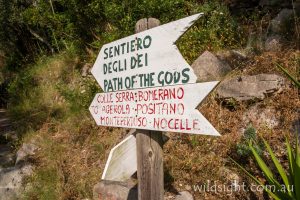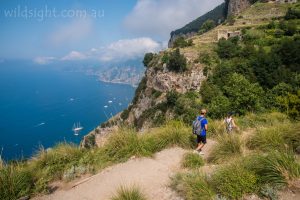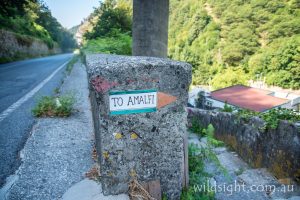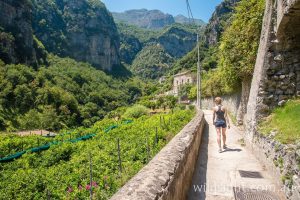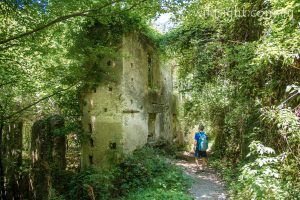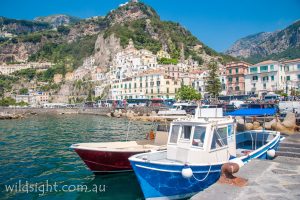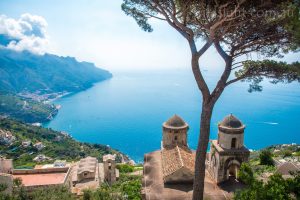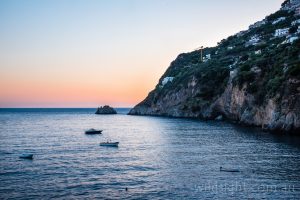The Amalfi Coast is a 50km stretch of coastline between the Gulf of Naples and the Gulf of Salerno, about 300km south of Rome. The Lattari Mountains form a rugged spine of the Sorrento peninsula, rising to 1131m, and the steep southern slopes are dotted with lemon groves and tiny farming villages that cling to the hillside in between sections of bare limestone cliffs. A series of walking trails, many of them carved into the hillside by Greek settlers in the eighth century BC, navigate those dramatic slopes, often starting or ending at the ridiculously picturesque fishing towns that dot the coast. And they usually involve a lot of steps.
Here are five of the best hikes on the Amalfi Coast.
PATH OF THE GODS
11km, 3-4 hours
The official trailhead to the region’s most famous walk, Sentiero degli Dei, is in Bomerano, a district of Agerola – take a Sita bus west from Amalfi. But most walkers join the trail a short distance along above the town of Praiano. Look for the Piaza San Luca, a square outside Parrocchia San Luca Evangelista – the Church of Saint Luca. Follow a flight of stone steps uphill, crossing one road before reaching another with a sign pointing to Sentiero Degli Dei via more steps (this area can be confusing, if in doubt keep following the steps uphill). Eventually you will intersect the official trail, marked by another sign.
Turn left here and follow the clear track towards the famous seaside town of Positano, about 10km away. There is more climbing initially but the path is mostly level as it follows the cliffline, passing a ruined monastery, a short section of forest and two narrow passes (don’t look down) with consistently breathtaking views over the ocean almost a kilometre below and to the island of Capri 22km off shore. The name of the track gives an indication of the outstanding scenery.
The path officially ends at the town of Nocelle, about two hours’ walk from Praiano and still high in the hills. You can catch a bus from here but it’s more fun to descend to Positano via 1800 steps (which make it clear why you don’t walk this track in the other direction). At Positano enjoy a gelato, try spotting a celebrity (the town is a favourite of the rich and famous) then hop on a bus or a water taxi back to where you started.
VALLEY OF THE MILLS
11km, 4-5 hours
Start this delightful day trip at Chiesa di Santa Maria a Gradillo, a 12th Century church at the northern end of the town of Ravello, which can be reached via a short and occasionally hair-raising bus or taxi ride from the coast – the town is 385m above sea level and worth a visit in its own right to explore the stunning gardens at Villa Cimbrone (which hosts orchestral concerts on a stage perched over the cliff edge) and Villa Rufolo (home to a balcony lined with Roman busts known as the “infinity ledge”).
The path starts opposite the church at the top of a set of stone steps on the other side of the road. Follow the steps downhill, crossing the road at several points and picking up the path again on the other side. Some road walking is required–remember Italians drive on the right-hand side of the road, at least when they can be predicted to drive in accordance with the road rules, which isn’t often.
The path passes a used car dealership before a longer stretch of road walking – avoid the road to the right to Pontone, continuing straight to round a hairpin bend then pick up a path that will lead all the way to the coast after leaving the road via steps on the right-hand side. This is a magical stretch of trail known as the Valle del Dragone that winds downhill through a valley passing the ruins of a small village, lemon groves, lush vegetable gardens and active farmhouses to reach a series of narrow alleyways in the seaside town of Atrani.
The path emerges in the town square opposite the beach about one hour after leaving Ravello. Take a quick detour to dip your toes in the Mediterranean before picking up the trail again at the southern end of the beach. Cross the road just before a tunnel and climb the steps on the other side (a great spot to photograph the postcard view below you of the historic town and its beach blanketed with blue and white umbrellas).
The path heads east along more narrow alleys to emerge above the road again just outside Amalfi, the biggest town on the coast and a world-famous holiday destination. It’s also a good spot for lunch (and further exploration if you have time, the cathedral is especially beautiful) before setting out on the second section of the walk, which is more beautiful than the first, but also more challenging.
Amalfi sits at the mouth of a steep rocky gorge, and that’s where the path heads before climbing back to Ravello. From the bottom of the cathedral steps follow the street (Via Lorenzo D’Amalfi) east as it climbs and narrows. At a car park a path leaves the road; follow the signs to Valle Delle Ferriere (Valley of the Mills). After climbing past more lemon groves the path enters a cool, green forest passing tumbling streams and several small waterfalls, and captivating ruins of 200-year-old paper factories that have been reclaimed by the forest.
The path climbs past the mills and eventually reaches the town of Pontone, which sits on the rocky prow that divides Amalfi and Atrani. It’s a steep climb with no shade after leaving the forest so the town is a good spot for a break and a cold drink. From here follow the main road (Via Valle delle Ferriere) back to the main road to Ravello. Follow the instructions from earlier in the day in reverse to climb back to the walk start via steps and stretches of roadway.
PUNTA CAMPANELLA
8km, 4 hours
This trek to the end of the Sorrento Peninsula is steeped in history and boasts outstanding coastal views. Start at the town square in Termini (get a bus from Amalfi or Sorrento). Follow signs to the cobblestone path (the remains of an ancient Roman road) that heads south; when the trail splits stick to the right for the flatter, seaward path that passes through vegetable gardens and olive groves with views to the island of Capri, which was shaved off the end of the peninsula by glaciers 20,000 years ago.
It’s easy going to the tip of the peninsula, marked by a watchtower built in the 14th Century to protect against a naval invasion by the Ottoman Empire. On top of the tower was a bell that was run in times of danger to communicate with other towers along the coast. This was also a landing point for ancient Greek and Roman ships; the Greeks built a temple here to honour Athena, the goddess of war, that was later converted by the Romans into a sanctuary devoted to Athena’s equivalent Minerva.
After exploring the historic site head back along the same path until you reach red and white stones that mark a junction with the higher route. This path heads directly up the slope (suberb views over Leranto Bay are a welcome distraction) to another track junction–follow the sign to climb Mount San Costanzo and see the ruins of an old chapel perched on top, 485m above sea level. Soak in the incredible vista before returning to Termini via an
old donkey track.
TORRE DELLO ZIRO
5km, 2-3 hours
This shorter trail harks back to Amalfi’s glory days, when the Duchy traded grain, salt and slaves for gold dinars and Byzantine silks, and also features more sensational views from the end of the dramatic rocky prow above Amalfi.
The walk starts in Pontone, which can be reached via bus or taxi from Amalfi or the footpath from Ravello – see notes above to the Valley of the Mills. From the town square follow the road for about 10 minutes before picking up the trail near the Church of Santa Maria del Carmine marked “torre” that heads south along the prow, descending on almost 800 steps as it passes through pine forest before reaching the tower, built in the middle ages to ward off pirates.
The tower and the paths around it that wind between the ruins provide fantastic photo opportunities overlooking Amalfi , Atrani and the coast below, and of the cliffs above. The site has a dark history – the Duchess of Amalfi and her children were imprisoned and murdered here in the 16th Century. Return to Pontone via the same path.
AVVOCATA SANCTUARY
16km, 6-7 hours
The Sanctuary of the Blessed Virgin Mary Advocate, or the Avvocata Sanctuary, is a monastery perched on the edge of a cliff, a sacred site that offers, in the words of one Italian website, “the best view in the world”.
Getting there requires a steep uphill walk starting at Via Casale dei Cicerali, an old alleyway in the town of Maiori. A flight of steps leads through lemon groves and vineyards then gives way to a mountain path, climbing steadily for about 30 minutes to the Acqua del Castagna spring, where walkers can rest and refill water bottles – the track gets steeper from here.
Pass through a fern grove, patches of forest and farming pasture and a grotto en route to a rocky spur about 5km from the spring. The sanctuary is perched on the spur at 1014m, offering grandstand views over the Gulf of Salerno.
It requires a few more steps but take the opportunity to visit the cave where a local shepherd is said to have seen a vision of the Virgin Mary, who instructed him to build a sanctuary here. This is a venerated site around the Campania region – every Monday after Pentecost worshippers trek up the steep path to the sanctuary before camping out on the ridge, engaging in festivities until the statue of the Madonna is paraded among the crowd under a shower of rose petals. The faithful then return to Maiori via the same path – you should do the same!
HISTORY
The town of Amalfi, now packed with tourists enjoying a gelato or an Aperol Spritz, was once a maritime power that lured traders from around the Mediterranean. One of the world’s first and biggest creators of paper, Amalfi declared itself a Republic 839 AD and issued its own gold currency, the Tari. It survived attacks over the centuries that followed from nearby powers including Republic of Pisa but two outbreaks of the plague and a devastating sea storm in the 14 th Century combined to end Amalfi’s Republican era. It returned to life as a sleepy fishing village until the area’s stunning beauty was discovered by travellers and poets in the 1800s, when a road was also constructed to link the fishing towns along the coast. Today they attract visitors from around the world.
CLIMATE/WHEN TO GO
April to June is the best time to visit to enjoy warm sunny weather while avoiding the tourist crush in July and August and oppressive heat later in the year.
NAVIGATION
Walking paths are mostly sign-posted and easy to follow, but the narrow streets and alleyways can be confusing. Maps and an international GPS app are helpful, and don’t be scared to ask for directions!
ACCOMMODATION
There are hundreds of hotels along the coast, including some budget options and plenty at the luxury end of the price scale. Air B&B or self-contained apartments are also popular. Glamping is an option, but leave your own tent at home.
GETTING THERE
From Rome take a train to Naples (about an hour), then a local Circumvesuviana train to Sorrento. From here buses and ferries take you to the towns of the Amalfi Coast.
WHERE TO EAT AND DRINK
Finding something to eat or drink in Italy is never a problem. Take some Euro with you on any walk to buy a limonata (soft drink made with the region’s sweet lemons) or slice of pizza at any of the towns you pass through. A gelato or granita (semi-frozen drink) are almost a must at the end of any summer walk.
MAPS
A 1:50,000 map of Sorrento and the Amalfi Coast is available but for more detailed notes look for the Sunflower Sorrento-Amalfi-Capri guidebook. Hotels and tourist information centres hand out local maps and the staff are the best source of information – they are all very friendly so don’t hesitate to ask!
VISAS
A valid passport is required for any Australian to visit Italy but not visa is needed for trips of less than 90 days. From 2021 a European ETIAS authorisation will become mandatory for all visitors.
OTHER RESOURCES
amalficoast.com and positano.com are good places to plan your trip, book accommodation and tours and get an overview of the best walks and outdoor activities.
